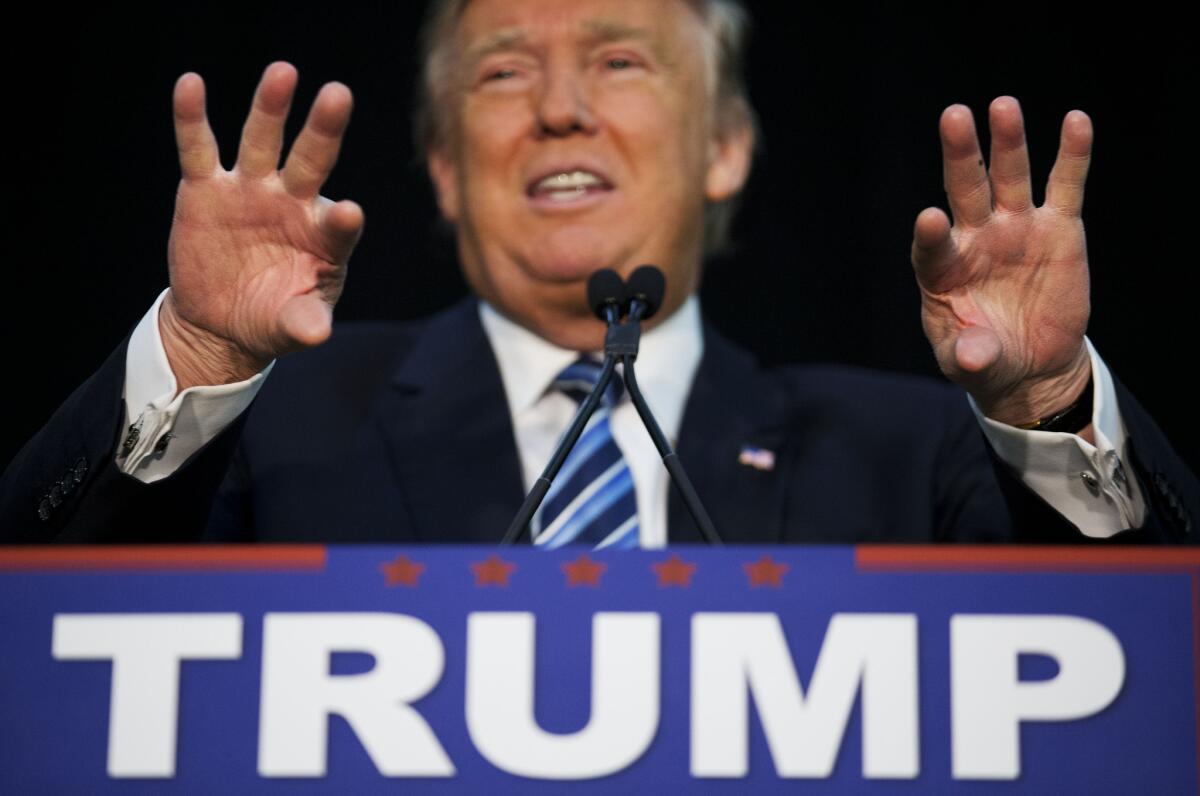The good, the bad and the ugly campaign ads of 2016 so far

Donald Trump, shown on Feb. 7, 2016, has given a list of reasons for his second-place finish in the Iowa caucus. Data from political advertising tracker Kantar Media reveal another possible explanation: he got pummeled on TV political-advertising.
- Share via
Count yourself lucky if you don’t live in Iowa, New Hampshire, South Carolina or Nevada. You’ve been spared from the greatest onslaught of political advertising in history.
Since Jan. 1, candidates for president and their supporters have aired more than 210,000 television commercials, almost all in those four early-voting states. The Wesleyan Media Project, a research group at Wesleyan University, has calculated that spending on ads has already reached $156 million, almost triple what was spent by this point in the 2012 campaign.
Here’s the worst part: Most of those commercials aren’t very good. Campaign advertising is arguably one of America’s cultural gifts to the world, along with jazz and muscle cars. Some campaigns produce ads that are tiny gems of the videographer’s art — Ronald Reagan’s 1984 “Morning in America” commercial, for example.
This year, however, they’re not much fun to watch.
“The overall quality is down,” says John G. Geer of Vanderbilt University, who has been studying campaign commercials for decades, poor fellow. “In a 24/7 campaign, they’re all under pressure to respond to charges instantly. It’s as if they don’t have time to make the ads any better.”
Still, there have been exceptions. And some of the most entertaining commercials have come from a candidate who rarely strikes voters as warm and fuzzy: Ted Cruz.
I’ve watched dozens of these commercials so you don’t have to. Here’s a sample of 2016’s first wave of political advertising:
Cleverest Republican ad: “Invasion,” Ted Cruz. A platoon of actors in business suits wade across a river to dramatize Cruz’s argument that the immigration issue would play differently if the migrants were lawyers and journalists instead of mostly unskilled workers.

Cleverest Republican ad (runner-up): “I Like Ted Cruz,” Keep the Promise PAC. A collection of Donald Trump’s past endorsements of Cruz, sponsored by a committee supporting the Texas senator.
Most powerful Democratic ad: “Brave,” Hillary Clinton. At a town meeting, a Latina girl bursts into tears as she tells Clinton she’s afraid her parents will be deported, and the candidate promises that everything will be alright.

Most powerful Democratic ad (runner-up): “It’s Not Over,” Bernie Sanders. The daughter of Eric Garner, an African-American man who died when police officers put him in a chokehold in 2014, explains why she’s decided to support the Vermont senator.
Gauziest Democratic ad: “America,” Bernie Sanders. Viewers either love this one or hate it: pretty pictures of Sanders supporters, a soundtrack from Simon and Garfunkel, and no added words at all. “It’s a throwback to the 1960s,” griped Geer. “All that was missing was the pot-smoking.”

Most factually-challenged ad: “Clear Difference,” Donald Trump. Trump repeats his claims on illegal immigration: “We have people pouring in, they’re pouring in, and they’re doing tremendous damage if you look at the crime.” In fact, net migration has declined, and evidence suggests that illegal immigrants commit crimes less often than U.S. citizens.

Most factually-challenged ad (runner up): “Themselves,” Ted Cruz. The candidate blames both parties for dysfunction in Washington, and promises to “press for term limits on judges and politicians… If that doesn’t drain the swamp, I’ll make them work weekends.” One problem: a president has no power to impose term limits – or make Congress work on weekends.
Best negative ad, Republican: “Not a President,” Right to Rise PAC. This one’s a radio ad – a compilation of all the bad language Trump has used on the campaign trail, with the profanities bleeped out. “Is this the type of man we want our children exposed to?” a narrator asks. Sponsored by a Super PAC supporting Jeb Bush.

Best negative ad, Democratic: No winner so far – because the Democratic campaign has been unusually decorous (at least on television).
Sanders has run commercials that throw an elbow at Clinton, blaming economic stagnation on politicians who take “millions in campaign donations and speaking fees,” but he never mentions her by name. Clinton’s campaign has run ads that say she would “build on Obamacare, not start over; break through the gridlock, not add to it” –echoing criticisms she has made of Sanders. But compared to the bareknuckled GOP race, those ads are downright collegial.
This year’s campaign includes one more experiment: How much money can a campaign spend on advertising without producing appreciable results?
Jeb Bush’s campaign and its allied super PAC have broken all records, spending more than $62 million on advertising, according to Wesleyan’s estimates — but the former Florida governor hasn’t come close to winning a primary.
Does that mean future campaigns will use less advertising? Not a chance.
Even though years of academic research has found that television commercials have only a marginal effect on voters’ behavior, no candidate wants to risk giving up even a sliver of a percentage point.
“It’s like an arms race,” Geer observed. “Every candidate has to engage in it, because otherwise they would give their opponents a one-sided advantage.”
So if you’ve been feeling left out, don’t worry. The campaign still has more than nine months to go. Those commercials, good and bad, will fill your television screen all too soon.
Follow the Opinion section on Twitter @latimesopinion and Facebook
More to Read
A cure for the common opinion
Get thought-provoking perspectives with our weekly newsletter.
You may occasionally receive promotional content from the Los Angeles Times.










